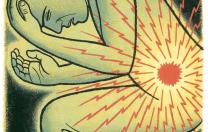The difficulty of treating pain flows in part from the difficulty people have in expressing and characterizing their painful sensations. In her essay “On Being Ill,” Virginia Woolf observed that literature rarely portrays bodily pain. “English, which can express the thoughts of Hamlet and the tragedy of Lear,” she wrote, “has no words for the shiver and the headache....The merest schoolgirl, when she falls in love, has Shakespeare or Keats to speak her mind for her; but let a sufferer try to describe a pain in his head to a doctor and language at once runs dry.”
Cabot professor of aesthetics and the general theory of value Elaine Scarry says, “We often recognize pain only if we see body damage or the weapon that caused the damage and, sometimes, not even then.” While researching her book The Body in Pain: The Making and Unmaking of the World (1985), Scarry, a participant in Harvard’s Mind/Brain/Behavior interfaculty initiative, studied literature and art, medical case histories, documents on torture, and legal transcripts of personal-injury trials. “Many physicians still look on patients as unreliable narrators,” she says. And this often happens, she believes, because it is enormously difficult to put physical pain into words. “When someone’s hurt, you can see [the capacity for] language being destroyed,” she says. “They utter a monosyllable or cry.”
The unsharability of pain its ability to destroy language is a major contributor to unrelieved suffering. “To have pain is to have certainty,” Scarry writes. “To hear about pain is to have doubt.” When she was working on her book in the late 1970s and early 1980s, Scarry felt optimistic because specialized pain clinics were opening. Yet, over time, she noticed that pain continued to be undertreated.
Medicine has attempted to come to grips with the elusiveness of pain, to help in its treatment. In 1975, 10 years after he and Patrick Wall set forth their gate control theory of pain, Ronald Melzack introduced the McGill Pain Questionnaire. This diagnostic tool, designed to help patients articulate the character of their pain, measures subjective pain experience to facilitate communication between patient and doctor. Patients are asked to rate the intensity of their pain on a numerical scale and to choose among adjectives such as “pinching,” “pulling,” “burning,” and “vicious” to describe the sensory and affective components they are experiencing. Although it can be a valuable tool, the questionnaire often goes unused and even when used, it is not enough to convince some doctors that a patient’s pain is genuine.
Many doctors believe that the pathology underlying the pain doesn’t merit the patient’s level of complaint, says Rabb professor of anthropology and professor of psychiatry Arthur Kleinman, who offers an uncomplicated solution. “In the pain field,” he says, “ethics should precede epistemology.” In other words, doctors should first acknowledge that the patient’s pain is real before interrogating him or her about its sources.
But doctors’ medical-school training and the way they have to function in hospitals encourages a sense of doubt, notes Kleinman, drawing on his own clinical experience. “If there is a single experience shared by virtually all chronic pain patients,” he writes in The Illness Narratives: Suffering, Healing, and the Human Condition, “it is that at some point those around them chiefly practitioners, but also at times family members come to question the authenticity of the patient’s experience of pain.
“This response contributes powerfully to patients’ dissatisfaction with the professional treatment system and to their search for alternatives,” Kleinman continues. “Chronic pain discloses that the training and methods of health professionals appear to prevent them from effectively caring for the chronically ill. Reciprocally, chronic pain patients are the bêtes noirs of many health professionals, who come to find them excessively demanding, hostile, and undermining of care. A duet of escalating antagonism ensues, much to the detriment of the protagonists.”








